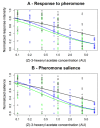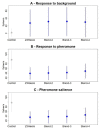Effects of Multi-Component Backgrounds of Volatile Plant Compounds on Moth Pheromone Perception
- PMID: 34062868
- PMCID: PMC8147264
- DOI: 10.3390/insects12050409
Effects of Multi-Component Backgrounds of Volatile Plant Compounds on Moth Pheromone Perception
Abstract
The volatile plant compounds (VPC) alter pheromone perception by insects but mixture effects inside insect olfactory landscapes are poorly understood. We measured the activity of receptor neurons tuned to Z7-12Ac (Z7-ORN), a pheromone component, in the antenna and central neurons in male Agrotis ipsilon while exposed to simple or composite backgrounds of a panel of VPCs representative of the odorant variety encountered by a moth. Maps of activities were built using calcium imaging to visualize which areas in antennal lobes (AL) were affected by VPCs. We compared the VPC activity and their impact as backgrounds at antenna and AL levels, individually or in blends. At periphery, VPCs showed differences in their capacity to elicit Z7-ORN firing response that cannot be explained by differences in stimulus intensities because we adjusted concentrations according to vapor pressures. The AL neuronal network, which reformats the ORN input, did not improve pheromone salience. We postulate that the AL network evolved to increase sensitivity and to encode for fast changes of pheromone at some cost for signal extraction. Comparing blends to single compounds indicated that a blend shows the activity of its most active component. VPC salience seems to be more important than background complexity.
Keywords: moth; odor background; odorscape; olfactory coding; olfactory neuron; pheromone; plant volatile compounds.
Conflict of interest statement
The authors declare no conflict of interest. The funders had no role in the design of the study; in the collection, analyses, or interpretation of data; in the writing of the manuscript, or in the decision to publish the results.
Figures









Similar articles
-
A Background of a Volatile Plant Compound Alters Neural and Behavioral Responses to the Sex Pheromone Blend in a Moth.Front Physiol. 2017 Feb 10;8:79. doi: 10.3389/fphys.2017.00079. eCollection 2017. Front Physiol. 2017. PMID: 28239358 Free PMC article.
-
Unexpected plant odor responses in a moth pheromone system.Front Physiol. 2015 May 12;6:148. doi: 10.3389/fphys.2015.00148. eCollection 2015. Front Physiol. 2015. PMID: 26029117 Free PMC article.
-
A plant volatile alters the perception of sex pheromone blend ratios in a moth.J Comp Physiol A Neuroethol Sens Neural Behav Physiol. 2020 Jul;206(4):553-570. doi: 10.1007/s00359-020-01420-y. Epub 2020 Apr 25. J Comp Physiol A Neuroethol Sens Neural Behav Physiol. 2020. PMID: 32335729
-
Working range of stimulus flux transduction determines dendrite size and relative number of pheromone component receptor neurons in moths.Chem Senses. 2012 May;37(4):299-313. doi: 10.1093/chemse/bjr122. Epub 2012 Jan 9. Chem Senses. 2012. PMID: 22230170 Review.
-
Electrophysiological responses of olfactory receptor neurons to stimulation with mixtures of individual pheromone components.Ann N Y Acad Sci. 1987;510:79-85. doi: 10.1111/j.1749-6632.1987.tb43470.x. Ann N Y Acad Sci. 1987. PMID: 3324881 Review.
Cited by
-
Combination of Chitosan and Essential Oils for Tomatoes Protection Against the Insect Pest Spodoptera littoralis (Lepidoptera: Noctuidae).Insects. 2025 Jul 12;16(7):718. doi: 10.3390/insects16070718. Insects. 2025. PMID: 40725348 Free PMC article.
-
Understanding responses to chemical mixtures: looking forward from the past.Chem Senses. 2022 Jan 1;47:bjac002. doi: 10.1093/chemse/bjac002. Chem Senses. 2022. PMID: 35226060 Free PMC article.
References
-
- Kantsa A., Raguso R.A., Lekkas T., Kalantzi O.I., Petanidou T. Floral volatiles and visitors: A meta-network of associations in a natural community. J. Ecol. 2019:1–13. doi: 10.1111/1365-2745.13197. - DOI
-
- Knudsen J.T., Tollsten L., Bergstrom G.L. Floral scents—A checklist of volatile compounds isolated by head-space techniques. Phytochemistry. 1993;33:253–280. doi: 10.1016/0031-9422(93)85502-I. - DOI
Grants and funding
LinkOut - more resources
Full Text Sources

